I Listened To Seven Sleater-Kinney Albums In Seven Hours
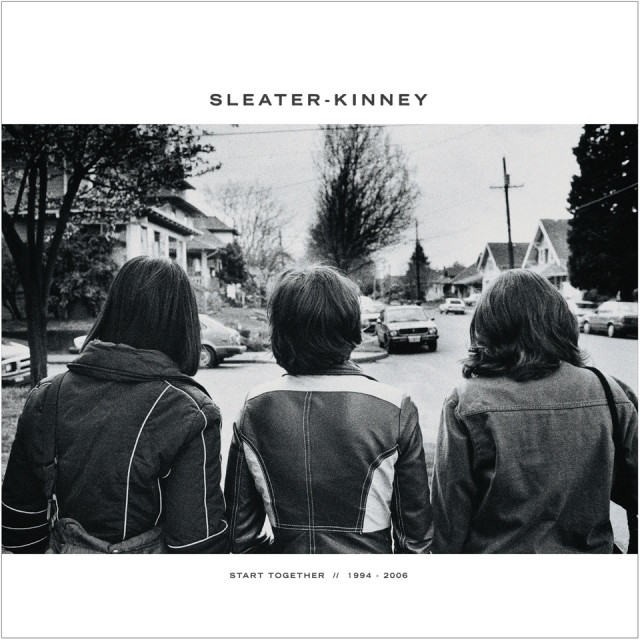
Sleater-Kinney's remaster box set, Start Together.
Sleater-Kinney is a matchless force in punk rock history. From 1995 to 2005, the Northwest natives recorded seven studio albums, spanning raw, politically minded rejection rock to tight, intimate alternative. The trio’s been given accolades across their career, lauded for their progressive tendencies both sonically and lyrically.
It’s been almost 20 years since Sleater-Kinney released their self-titled debut and nearly a decade since their break up. Sub Pop, the Seattle label that released their final album, decided it’s time to remaster their catalog into one hefty, limited-edition box set, titled Start Together.
Filled with all seven records pressed in colored vinyl and a 44-page hardcover book of unseen photographs, plus a digital download, the set, slated for October 21, will run you $125. Rumors are swirling that the set comes with a brand new 7-inch single titled "Bury Our Friends" marked with the date "1/20/15." A sly hint of a release date, perhaps?
We decided to celebrate the release of Start Together by doing what any self-respecting music fan would do after purchasing a box set: strap on headphones and listen to the band’s entire catalog from start to finish.
11:30 am
I press play on Sleater-Kinney, awfully apologetic to my neighbors who I probably just brutally woke up with Carrie Brownstein’s bracing guitar. Keep in mind this wanton wake up routine is only made possible because my girlfriend is in Seattle for three days. Unorthodox, I know, taking advantage of my limited hours as a bachelor by blaring riot grrrl rock across my one-bedroom apartment.
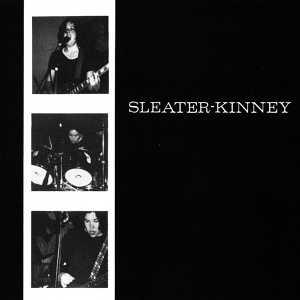
Sleater-Kinney's eponymous debut
As I begin to make breakfast, Corin Tucker dives into her snarkily piercing way of relaying broken love lyrics. The theme—a wary state of rejection—recurs throughout much of Sleater-Kinney’s music, an angst that will rail against anything from ex-lovers to American culture.
The gender-role resistant vigor of songs like “A Real Man” and “How To Play Dead” immediately place Sleater-Kinney within the context of their fellow female-led Olympia, Washington natives. There's this edgy autonomy, a waggish antagonism that’s present in lines like “All girls should have/A real man” or more explicitly with “I won't suck your big ego/And swallow all my pride/And I'm spitting out your memory/And stains you left inside of me.” This snide and pointed cynicism is what always lured me to Sleater-Kinney’s brand of punk.
Noon

The trio's sophomore effort, Call The Doctor
It’s been thirty minutes and I’m now sitting in my living room sipping a mug of coffee and entering 1996’s Call The Doctor.
Tucker’s stubborn ways remain present on the band’s sophomore effort. Stretched harmonies take over the first verse on “Hubcap” as Tucker and Brownstein trade extended notes. They begin to balance their rough garage punk tendencies with a more controlled and calculated sound.
They push back with the heady “I’m Not Waiting,” a forceful declaration of womanhood. “I'm not waiting/ ‘till I grow up/ To be a woman” is coupled with “Your words are sticky stupid running down my legs” to create a powerful, graphic dynamic that simultaneously unites and isolates the listener and singer.
Call The Doctor‘s more poised than the trio’s debut, with a healthy fix of unkempt grit and practiced composure. The album catapulted the girls from their Northwest dwellings to the national stage with a 4/5 rating from Rolling Stone.
1:30 pm
Listening to any artist’s full oeuvre would be exhausting, but listening to Sleater-Kinney’s is exceptionally draining. They’re sound is brazen and mulish. It’s by no means easy listening, and it begs close attention. So forgive me, but I needed to take a quick break before I laid the needle onto the trio’s third effort, Dig Me Out.
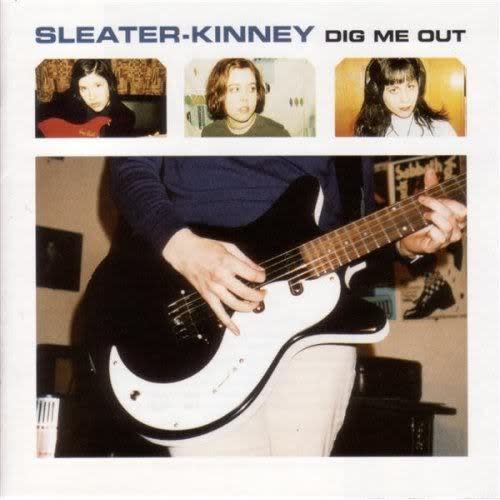
1997's Dig Me Out.
The 1997 record continues to build layers to Sleater-Kinney’s style. Dig Me Out marks Janet Weiss's first album as the band's official drummer, replacing Lora McFarlane. Her presence is made evident through snappy, pithy drums.The band’s a bit cleaner, with Tucker’s vocal range more readily at the forefront. “Turn It On” is a nice example of their music’s maturity, stepping beyond their Seattle grunge and lo-fi cohorts to embrace a more comprehensive sound.
There’s also this beautiful, tortured break-up element of Sleater-Kinney’s music that continues to present itself. It’s different from the subversive riot grrrl tendencies; it’s more intimate and personal. The refrain on “Heart Factory” dives into callous rejection territory with lines like “Fucks me up/I'm not just made of parts/And you can break right through/This box you put me into.”
Dig Me Out presents a more focused and self-aware band. The trio keeps finding new ways to express themselves and remain fresh.
3:00 pm
I’ve been cooped up in my Northwest apartment since 11 and have listened to 35 Sleater-Kinney songs. This is more of a marathon than I anticipated, I think, as I realize I’m not even half way there. There's a daunting four more albums yet to sift through. I eat lunch, take a shower, and then walk downtown.
I decide to go to Powell’s because it’s a free place to work, and there’s something unruly and utterly punk about listening to loud, unabashed rock in a friendly bookstore. I sit in the café by a window facing Burnside and listen to 1999's The Hot Rock.
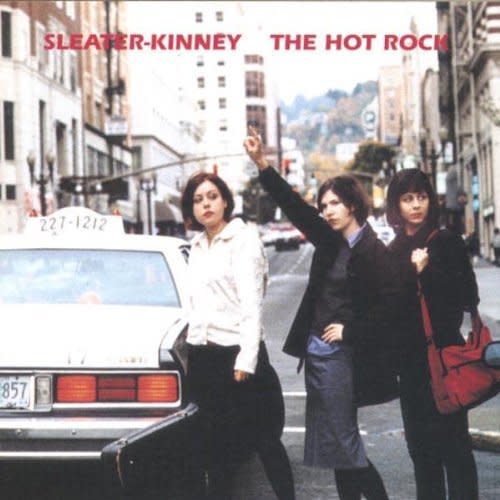
Sleater-Kinney's fourth studio album, The Hot Rock
I’m the outlier here, the isolated kid in a flannel with headphones on feverishly shaking his foot and tapping his laptop keyboard. I look like I’m working, but my screen shifts between iTunes, lyric websites, and a disorganized Google document. Also, now that I’m in public, I have the constant fear that Tucker’s wail or Brownstein’s reverb will seep out from under my ratty ripped headphones and aggravate everybody around me.
I press play on the box set’s namesake and The Hot Rock’s first song, “Start Together.” The opening two lines—“If you want me it's changing/ If you want everything's changing”—offer an apt start to an album that marks a distinct shift in the trio’s sonic trajectory. The sound is airy and lighter than the hardheaded punk of their previous years.
The vocal duels between Brownstein and Tucker are tighter on this record. “Burn, Don’t Freeze” presents a web of overlapping and competing melodies. Singing divergent lyrics risk leaving the listener disoriented, but there’s something about their voices that are complimentary, that give depth and dimension to their sound.
The Hot Rock presents some of Sleater-Kinney’s most experimental arrangements, with violin parts on “The Size of Our Love” and a slide guitar on “A Quarter To Three.” Undoubtedly, day-one fans were ambivalent to the band’s changing sound, but personally, after listening to three lo-fi post-grunge records in three hours, the more indie-leaning stylings are certainly a welcomed move.
4:00 pm
I’m still at my post at Powell’s and haven’t gotten a noise complaint so onward to the new millennium’s All Hands on the Bad One. It’s the band’s fifth studio album in five years, and the first one to be recorded in Portland.
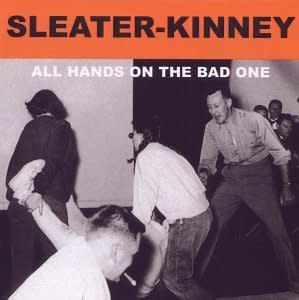
All Hands On The Bad One
This album marks the return of John Goodmanson, who produced Call The Doctor and Dig Me Out. Goodmanson’s ear may very well be responsible for a reinvigorated Sleater-Kinney verve.
The lyrical checklist is complete here: female empowerment (“You’re No Rock and Roll Fun”), a takedown of the media (“The Professional”), and rejection (“Milkshakes & Honey”).
The final song, “The Swimmer,” is a telling display of where the band was physically. It’s soft and simple but begs attention. It’s a very solitary song, but there’s a comfortable quality that draws you in closer. It’s grey and inviting—kind of like the Pacific Northwest, right?
5:30 pm
With two more albums still to digest, I leave Powell's and begin to walk back towards my apartment. I veer down NW 17th Avenue and set up shop outside Paymaster Lounge. Equipped with a $2 pint of Hamms, I press play on One Beat.
The hollow, whirling drum intro already sets the albums apart from the others. It’s initially more playful, but Tucker’s high-pitched conviction is pressing. The production is bold and sturdy.
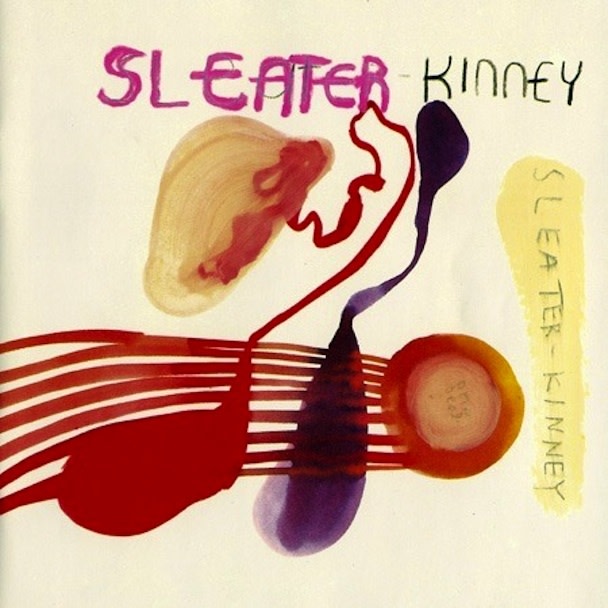
2002's One Beat
Politics are poignant as the record was released less than a year after 9/11. “Far Away” is a pointed, rage-filled reaction to the attacks, marrying Sleater-Kinney’s ability to portray both socially conscious and emotionally rife music. But no longer are they producing snappy punk standards; they’re way beyond that. The songs are longer, bridging on four minutes, and more diverse, as exhibited by Brownstein’s rousing, driving guitar parts at the end of “Far Away.”
The energy on their first several albums was unrestrained and raw. It’s certainly more controlled now, but it’s also willing to be experimental and psychedelic. A song like “Prisstina,” a feisty call for female empowerment, is peppered with a melodic synth intro and spacey sound effects.
One Beat is an ambitious, rich, and vibrant album full of boisterous psych rock and simple, gloomy crooning.
6:25 pm
I’m done with my beer and the night’s getting colder, so I walk back to my apartment to finish my Sleater-Kinney marathon on the comfort of my couch. It’s ceremonious, too, as this is where I began my journey into the trio’s debut, so this should be where I witness their final days.
Released in 2005, The Woods presents a more stripped down sound than the previous two records. There are no extraneous instruments or eccentric features, it’s just Tucker, Brownstein, and Weiss baring it all.

Sleater-Kinney's final studio album, The Woods.
Immediately, The Woods feels like a return to their old sound, with a shrill reverb-wrecked opening. Soon they settle in with “Wilderness,” a Brownstein-led tune about her family life growing up. It’s a radiant track that quickly dips into art rock territory with a wailing waa-waa affected bridge.
The Woods offers a far-reaching range of sounds that pulls from across Sleater-Kinney’s catalog. The album is less overtly political than past projects, but they remain socially conscious with cuts like “Jumpers,” a well-realized song about suicide.
Their range is what maintains spontaneity in Sleater-Kinney’s music; it’s what makes The Woods a fitting finale to their illustrious career. The album marches between raucous punk reminiscent of their early days (“Entertain”) and sweet, harmonica-filled folk melodies (“Modern Girl”). And, not to mention, a wholly atypical 11-minute sex-powered epic in “Let’s Call It Love.”
***
It’s been nearly seven hours since I began my voyage through Sleater-Kinney’s collection, and I’m drained. It has been revealing, placing every release physically in the context in which it was created. The band’s progression and maturity over their decade run is more tangible to me. From guttural feminist protest punk to intimate, revealing indie rock, the Washington-bred, Portland-relocated trio has produced some of the most captivating American rock music of the last two decades.
The full box set, with a book of photos and each album’s corresponding booklet, should honestly be as revealing as listening to all seven albums in one day. So would I recommend listening straight through? It was compelling, sure, a fascinating portrait of a prolific, multidimensional band, but it also left me feeling weary and full of angst.
Maybe take it one album at a time.




